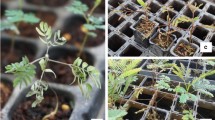Abstract
The influence of culture filtrates of Fusarium oxysporum f.sp. dianthi which causes Fusarium wilt was investigated on growth and viability of carnation tissue cultures and leaf segments. Culture filtrates of avirulent race 1 of this fungus did not affect calli and leaf segments of cultivars both susceptible and resistant to Fusarium wilt. However, culture filtrates of virulent race 2 decreased viability and suppressed growth of callus of the susceptible cultivar. In contrast, callus of the resistant cultivar showed resistance to the culture filtrates. The results of these experiments may provide information on methods of selection of new wilt resistant carnation varieties.
Similar content being viewed by others
Abbreviations
- A270:
-
absorbance at 270 nm
- 2,4-d :
-
2,4-dichlorophenoxyacetic acid
- CF-MCD:
-
culture filtrate of 16064 grown in MCD medium
- MCD medium:
-
modified Czapeck-Dox medium
- MS medium:
-
basal medium of Murashige and Skoog
- MW:
-
molecular weight
- PD medium:
-
potato dextrose medium
- TTC:
-
2,3,5-triphenyl tetrazolium chloride
References
Arai M (1988) Study on the resistance of carnation cells to Fusarium oxysporum f.sp. dianthi toxins and the mode of the resistance in intra-species somatic hybrid cells. Thesis for Master of Science, Saitama University
Arai M, Sugawara Y, Matsushima H & Takeuchi M (1989) Enhancement of colony formation of carnation (Dianthus caryophyllus) mesophyll protoplasts by abscisic acid pretreatment. Plant Tiss. Cult. Lett 6: 80–84
Bateman DF & Basham HG (1976) Degradation of plant cell walls and membranes by microbial enzymes. In: Heitefuss R & Williams PH (Eds) Physiological Plant Pathology (pp 316–355). Springer-Verlag, New York
Behnke M (1980a) Selection of dihaploid potato callus for resistance to the culture filtrates of Fusarium oxysporum. Z. Pflanzenzucht. 85: 254–258
Behnke M (1980b) General resistance to late blight of Solanum tuberosum plants regenerated from callus resistance to culture filtrates of Phytophthora infestans. Theor. Appl. Genet. 56: 151–152
Carrier LE (1978) Breeding for resistance in carnations. In: Proceedings of the Eucarpia Meeting on carnation and Gerbera, Alassio 151–152
Gäumann E (1957) Fusaric acid as a wilt toxin. Phytopathol. 47: 342–357
Gengenbach BG & Green CE (1975) Selection of T-cytoplasm maize callus cultures resistant to Helminthosporium maydis race T pathotoxin. Crop. Sci. 15: 645–649
Gray LE, Guan YQ & Wilholm JM (1986) Reaction of soybean callus to culture filtrates of Phialophora gregata. Plant Sci. 47: 45–55
Harling R & Taylor GS (1985) A light microscope study of resistant and susceptible carnations infected with Fusarium oxysporum f.sp. dianthi. Can. J. Bot. 63: 638–646
Hartman CL, McRoy TJ & Knous TR (1984) Selection of Alfalfa (Medicago sativa) cell lines and regeneration of plants resistant to the toxin(s) produced by Fusarium oxysporum f.sp. medicagins. Plant Sci. Lett. 34: 183–194
Ingram DS & Helgeson JP (1980) Tissue Culture Methods for Plant Pathologists. Blackwell Scientific Publications, Oxford
Mantell SH, Matthews JA & McKee RA (1985) Principles of Plant Biotechnology. Blackwell Scientific Publications, Oxford
Matthews P & Arthur AE (1978) Resistance and selecting for resistance to Fusarium wilt in carnation. In: Proceedings of the Eucarpia Meeting on Carnation and Gerbera, Alassio 127–139
Murashige T & Skoog F (1962) A revised medium for rapid growth and bioassays with tobacco tissue cultures. Physiol. Plant. 15: 473–497
Onions AHS (1971) Preservation of fungi. In: Norris FR & Ribbons DW (Eds) Methods in Microbiology, Vol 4 (pp 113–151). Academic Press, New York
Pennypacker BW & Nelson PE (1972) Histopathology of carnation infected with Fusarium oxysporum f.sp. dianthi. Phytopathol. 62: 1318–1326
Puhalla JE (1985) Classification of strains of Fusarium oxysporum on the basis of vegetative compatibility. Can. J. Bot. 63: 179–183
Simard M-H, Michaux-Ferriere N & Silvy A (1992) Variants of carnation (Dianthus caryophyllus L.) obtained by organogenesis from irradiated petals. Plant Cell Tiss. Org. Cult. 29: 37–42
Sparnaaij FE & Demmink JF (1977) Progress towards Fusarium resistance in carnation. Acta. Hort. 71: 107–113
Sparnaaij LD (1978) Current problems with Fusarium resistance breeding in Carnation. In: Proceedings of the Eucarpia Meeting on Carnation and Gerbera, Alassio 111–114
Steponkus PL & Lanphear FO (1967) Refinement of the triphenyl tetrazolium chloride methods of determining cold injury. Plant Physiol. 42: 1423–1426
Author information
Authors and Affiliations
Rights and permissions
About this article
Cite this article
Arai, M., Takeuchi, M. Influence of Fusarium wilt toxin(s) on carnation cells. Plant Cell Tiss Organ Cult 34, 287–293 (1993). https://doi.org/10.1007/BF00029718
Received:
Accepted:
Issue Date:
DOI: https://doi.org/10.1007/BF00029718




